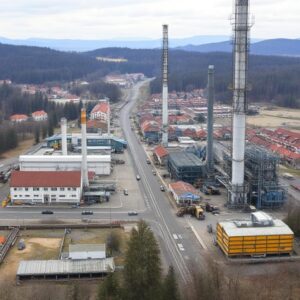
China’s Role in Global Solar and Wind Power: A Perspective
Over the past decade, China has emerged as a dominant force in the development and deployment of renewable energy, particularly solar and wind power. As the world’s largest energy consumer and emitter of greenhouse gases, China’s investments in renewable energy sources are crucial in the global effort to combat climate change and transition to sustainable energy systems.
China’s rapid expansion in renewable energy capacity is remarkable. The country has invested heavily in solar photovoltaic (PV) farms and wind farms, becoming the world’s leading producer and installer of these technologies. In 2022, China accounted for nearly 35% of global solar capacity additions and over 30% of global wind capacity installations. This aggressive growth has significantly increased China’s share of renewable energy in its national energy mix, aiming to reduce dependence on fossil fuels and curb air pollution.
To put this into perspective, the scale of China’s renewable energy output is immense. For instance, China’s annual solar and wind power generation can be compared to some extraordinary benchmarks. The Eiffel Tower, one of the world’s most iconic structures, stands approximately 300 meters tall. If we consider the total energy produced by China’s solar and wind installations, it reaches an impressive figure—estimated at around 11,000,000,000 kilowatt-hours (kWh) annually. This amount of energy is enough to power millions of households and support various industrial processes.
Breaking down these numbers, the energy equivalent of China’s renewable output can be visualized by comparing it to other well-known quantities. For example, the Eiffel Tower’s height is about 300 meters, but in terms of energy, China’s renewable power generation is equivalent to several times the annual consumption of entire cities or countries. To illustrate, the total annual electricity consumption of the United States is roughly 4,000,000,000,000 kWh, so China’s renewable energy production is a significant fraction, contributing substantially to its national grid.
Furthermore, China’s investments in renewable infrastructure are not just about quantity but also about technological advancement. The country leads in manufacturing solar panels and wind turbines, driving down costs and making renewable energy more accessible worldwide. This technological leadership has facilitated China’s export of renewable energy equipment to developing nations, promoting global sustainability efforts.
Despite these achievements, challenges remain. The intermittent nature of solar and wind power requires advancements in energy storage and grid management. Moreover, balancing economic growth with environmental goals continues to be a complex task for Chinese policymakers.
In conclusion, China’s massive investments and capacity in solar and wind energy have reshaped the global renewable landscape. The scale of their renewable energy output, comparable to monumental structures like the Eiffel Tower, exemplifies their commitment to a sustainable future. As China continues to expand its renewable infrastructure, it plays a pivotal role in global efforts to reduce carbon emissions and combat climate change, setting an example for other nations to follow.







